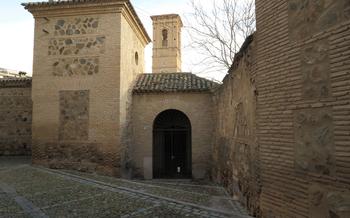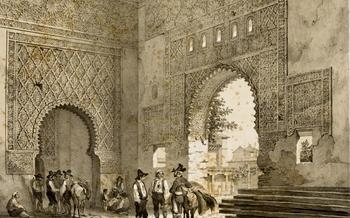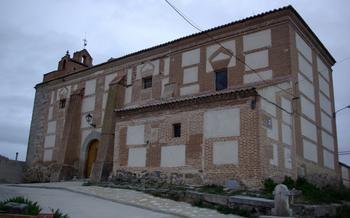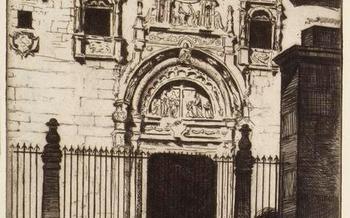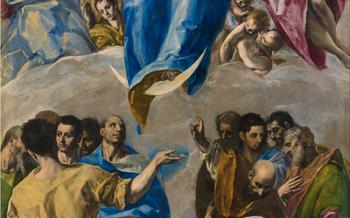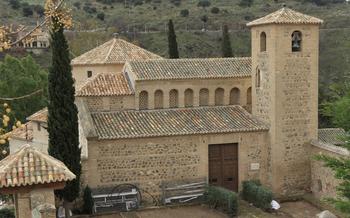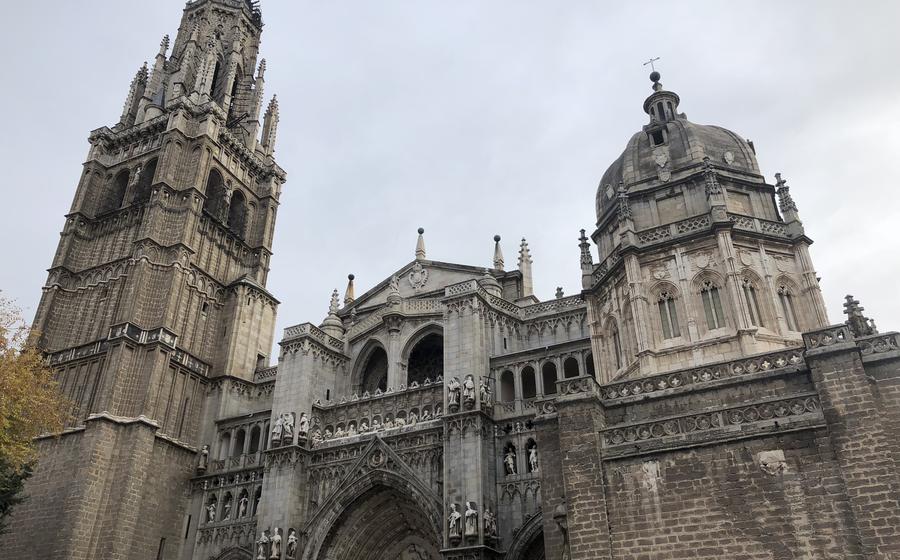
The Convent of Corpus Christi
- Historical Background
- Architectural Marvel
- Artistic Treasures
- Museum of Santa Cruz
- Cloister of the Convent
- Guided Tours
- Nuns' Choir
- Refectory
- Chapter 9: Exploring the Chapter House: A Place of Governance
- Chapel of San José
- Convent Shop
- Dress Code
- Photography
- Accessibility
- Insider Tip
Historical Background
Founded in 1484 by Queen Isabella I of Castile, the Convent of Corpus Christi in Toledo, Spain, played a pivotal role in the Catholic Reformation. The convent was established as a center of religious education and spirituality, dedicated to the strict observance of the Rule of Saint Clare. Its influence extended beyond Toledo, as it became a model for other convents throughout the country. The convent's architectural design reflects the blending of Gothic and Mudejar styles, showcasing the rich cultural heritage of Spain's medieval era. The preservation of the convent as a historical monument ensures that its architectural and spiritual significance continues to inspire and educate future generations.
Architectural Marvel
The Convent of Corpus Christi boasts a captivating architectural style that harmoniously blends Gothic and Mudejar influences. Its exterior facade is a testament to the intricate stone carvings and decorative elements that adorn the building. The Gothic-Mudejar style, prevalent in the region of Toledo, seamlessly merges the architectural traditions of Christian and Islamic cultures. As you gaze upon the convent's exterior, admire the delicate arches, ornate windows, and intricate tilework that showcase the artistry and craftsmanship of its builders.
Explore the various sections of the convent, each offering its unique architectural charm. The cloister, with its serene atmosphere, features graceful arches supported by slender columns. The chapter house impresses with its vaulted ceiling and decorative elements that exude an air of grandeur. The refectory, where the nuns once dined together, displays a simplicity that reflects their humble lifestyle.
Throughout the convent, you'll encounter a harmonious blend of Moorish and Christian architectural elements. The Mudéjar influence is evident in the intricate plasterwork, ceramic tiles, and geometric designs that adorn the walls and ceilings. These decorative elements, combined with the Gothic architectural features, create a distinctive and captivating aesthetic that sets the Convent of Corpus Christi apart.
Artistic Treasures
The Convent of Corpus Christi boasts a magnificent collection of artistic treasures that captivate visitors with their beauty and spiritual significance. Among the highlights is the stunning altarpiece in the main chapel, created by the renowned Spanish artist, El Greco. Its intricate carvings and vibrant colors depict scenes from the life of Christ and leave visitors in awe.
In addition to El Greco's masterpiece, the convent houses an impressive collection of paintings, sculptures, and tapestries created by other talented artists of the period. Visitors can admire the delicate brushstrokes and expressive faces in paintings depicting religious figures and biblical scenes. The sculptures, carved from wood and stone, showcase the skill and artistry of the sculptors, capturing the emotions and details of their subjects.
The tapestries, with their vibrant colors and intricate designs, tell stories from the Bible and the lives of the saints. Each artwork in the Convent of Corpus Christi holds a unique story, inviting visitors to contemplate their religious and artistic significance.
Museum of Santa Cruz
Housed within the historic walls of the Convent of Corpus Christi, the Museum of Santa Cruz is a treasure trove of religious art, archaeological artifacts, and historical documents. Wander through the museum's galleries and discover a diverse collection that spans centuries and civilizations. Admire stunning paintings, delicate sculptures, and intricate tapestries, each telling a story of faith, devotion, and artistic mastery. Explore the archaeological exhibits that shed light on the region's rich past, uncovering ancient artifacts that provide a glimpse into the lives and cultures of those who came before. Delve into the historical documents that chronicle the history of Toledo and the surrounding region, offering insights into the events and people that shaped this vibrant city. As you wander through the museum's halls, soak in the unique atmosphere created by the harmonious blend of art, history, and spirituality. The Museum of Santa Cruz is not just a repository of artifacts; it is a journey through time and culture, offering visitors a deeper understanding of the region's heritage and the enduring legacy of the Convent of Corpus Christi.
Cloister of the Convent
Strolling through the serene and picturesque cloister of the Convent of Corpus Christi is a journey into tranquility and spirituality. The intricate arches and delicate columns create a harmonious and visually stunning space, while the lush greenery adds a touch of natural beauty. The cloister serves as a place of contemplation and reflection for the nuns, and its peaceful atmosphere is palpable. Visitors can wander through the cloister, admiring the architectural details and soaking in the tranquility of this sacred space. The cloister is a reminder of the convent's rich history and its enduring commitment to religious devotion.
Guided Tours
Enhance your exploration of the Convent of Corpus Christi by taking advantage of the guided tours offered by the convent. These tours provide an opportunity to gain in-depth knowledge and insights from expert guides who share historical facts, anecdotes, and hidden gems of the convent.
With a guided tour, you'll discover lesser-known stories and details that may not be readily apparent to the casual visitor. The guides, who are passionate about the convent's history and heritage, bring the site to life by sharing their knowledge and expertise.
Whether you're a history buff, an architecture enthusiast, or simply curious about the life of the nuns, the guided tours offered at the Convent of Corpus Christi are an invaluable way to deepen your understanding and appreciation of this remarkable site.
Nuns' Choir
The nuns' choir, a sacred and secluded space within the Convent of Corpus Christi, holds a profound significance in the religious life of the nuns. Here, they gathered for daily prayers, sang hymns, and engaged in spiritual contemplation. The choir features intricate carvings and decorative elements that reflect the artistry and devotion of its creators. The ornate wooden choir stalls, with their delicate tracery and intricate designs, provide a glimpse into the craftsmanship and dedication that went into the construction of this special space.
Imagine the atmosphere of serenity and devotion as the nuns gathered in the choir, their voices blending in harmony, creating a celestial melody that echoed through the convent. The choir served as a sanctuary for the nuns, where they could connect with the divine and find solace and inspiration.
Visitors to the convent can step into the nuns' choir and experience the palpable sense of spirituality that lingers within its walls. It is a place to pause, reflect, and appreciate the unwavering faith and dedication of the nuns who have graced this sacred space for centuries.
Refectory
Step into the refectory, a dining hall that once served as the communal eating space for the nuns of the Convent of Corpus Christi. Here, you can envision the simple and austere lifestyle they led. The room's furnishings are basic, reflecting the nuns' focus on humility and devotion.
Imagine the nuns gathering in this space for their daily meals, sharing stories, and finding solace in one another's company. The refectory was more than just a place to eat; it was a place of nourishment and fellowship, a reminder of the bonds that united them as a community.
As you stand in the refectory, you can almost hear the echoes of their conversations, the laughter, and the prayers that filled this room over the centuries. It is a place that invites reflection on the values of simplicity, community, and the pursuit of a higher purpose.
Chapter 9: Exploring the Chapter House: A Place of Governance
Within the cloistered walls of the Convent of Corpus Christi lies the chapter house, a room of great significance. It was here that the nuns gathered to discuss important matters, make decisions, and conduct business related to the running of the convent.
Step inside this impressive chamber and admire the vaulted ceiling, which soars overhead. The intricate designs and decorative elements that adorn the walls and ceiling create a sense of awe and reverence. Imagine the nuns sitting in this very room, engaged in discussions that shaped the life of the community.
The chapter house served as a central hub for decision-making. Here, the nuns would deliberate on various issues, from the allocation of resources to the admission of new members. It was a place where the collective wisdom and experience of the community were brought together to guide the convent's future.
Through guided tours, visitors can gain insights into the governance structure of the convent. Expert guides share fascinating stories and anecdotes about the decisions that were made within these walls, shedding light on the challenges and triumphs faced by the nuns.
Visiting the chapter house offers a glimpse into the organizational and administrative aspects of the convent's history. It reminds us of the importance of collaboration, leadership, and decision-making in shaping the destiny of any community.
Chapel of San José
Tucked away within the Convent of Corpus Christi lies a hidden gem – the Chapel of San José. This intimate and prayerful space invites visitors to experience the spiritual depth and devotion of the nuns. Step inside and marvel at the intricate altarpiece, adorned with delicate carvings and vibrant colors. The beautiful frescoes that grace the walls depict scenes from the life of Saint Joseph, adding to the chapel's serene and meditative atmosphere. Find a quiet corner to sit and reflect, allowing the beauty of the chapel to envelop you. Imagine the nuns gathering here daily, seeking solace and guidance in their spiritual journey. The Chapel of San José is a testament to the deep faith and devotion that have sustained the Convent of Corpus Christi for centuries.
Convent Shop
The Convent of Corpus Christi offers a unique shopping experience in its charming convent shop. Browse a carefully curated selection of souvenirs, religious items, and locally produced goods. Discover handmade crafts, beautiful artwork, and thoughtful gifts that reflect the history and spirit of the convent.
Your purchases from the convent shop directly support the preservation and maintenance of this historic site. By choosing one-of-a-kind items, you not only take home a cherished memento but also contribute to the ongoing legacy of the Convent of Corpus Christi.
Dress Code
When visiting the Convent of Corpus Christi, it is essential to observe the dress code to show respect for the religious nature of the site. Visitors are expected to dress modestly, covering their shoulders and knees. This means avoiding shorts, tank tops, and revealing clothing. Conservative attire such as long pants, skirts, and blouses is recommended. By adhering to the dress code, visitors can contribute to maintaining the sacred atmosphere of the convent and ensure a respectful and enjoyable experience for all.
Photography
Photography is generally permitted within the Convent of Corpus Christi, but with certain restrictions. Visitors are asked to be respectful of the privacy of the nuns and other visitors. Using flash photography or taking photos during religious services is not allowed. Before photographing specific areas or individuals, it is polite to ask permission. By following these guidelines, visitors can ensure that they are not being disruptive or disrespectful while capturing their memories of this sacred site.
Accessibility
The Convent of Corpus Christi recognizes the importance of inclusivity and accessibility for all visitors. To ensure that everyone can experience the beauty and history of the convent, it is equipped with ramps and elevators to facilitate wheelchair access throughout the premises. Visitors with disabilities are encouraged to contact the convent in advance to arrange for any specific assistance they may require. Guided tours can be adapted to accommodate the needs of visitors with disabilities, ensuring that they have an equally enriching and enjoyable experience. Additionally, accessible restrooms are available on the convent grounds, providing convenience and comfort for all.
Insider Tip
To fully immerse yourself in the spiritual atmosphere of the Convent of Corpus Christi, plan your visit to coincide with one of its special events or religious festivals. Attending a Mass or prayer service will allow you to witness the nuns' devotion and spirituality firsthand. You can also participate in workshops or classes offered by the convent to delve deeper into its history, traditions, and artistic treasures. These special events provide a unique opportunity to connect with the essence of the convent and gain a deeper understanding of its significance.
